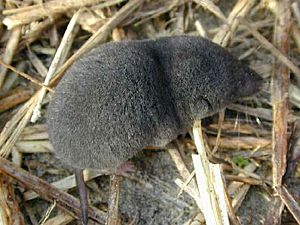Southern short-tailed shrew facts for kids
Quick facts for kids Southern short-tailed shrew |
|
|---|---|
 |
|
| Conservation status | |
| Scientific classification | |
| Genus: |
Blarina
|
| Species: |
carolinensis
|
 |
|
| Southern short-tailed shrew range | |
| Synonyms | |
|
Blarina brevicauda carolinensis |
|
Meet the southern short-tailed shrew (Blarina carolinensis), a small, gray animal with a short tail. It's a type of shrew that lives in the eastern United States. These tiny creatures are known for their fast-paced lives and unique ways of finding food.
Contents
About the Southern Short-tailed Shrew
The southern short-tailed shrew is the smallest shrew in its group, called a genus. It measures about 7 to 10 centimeters (3 to 4 inches) long. This is roughly the length of a small pencil. It weighs less than 14 grams (half an ounce), which is lighter than a few quarters!
This shrew has a strong body with short legs and a thick neck. It has a long, pointy nose and ears that are almost hidden by its soft, thick fur. As its name suggests, its furry tail is quite short, only about 1.2 to 2.5 centimeters (half an inch to one inch) long. Its feet are perfect for digging, with five toes that have sharp, curved claws. The fur is a dark gray color, becoming lighter on its belly.
Where Shrews Live
The southern short-tailed shrew lives in the southeastern United States. You can find it from southern Virginia all the way to eastern Texas. It also lives in the Mississippi valley, reaching as far north as southern Illinois.
These shrews mostly live in pine forests. However, they can adapt to many different places. They live in dry forests, wet and swampy areas, and even forests that have been disturbed. They also make homes in old farmlands.
There are two main types, or subspecies, of this shrew:
- B. c. carolinensis: This type lives from southern Virginia to northern Florida. It also extends west to eastern Mississippi, southern Illinois, and northeastern Texas.
- B. c. minima: This type is found in eastern Texas, Louisiana, and the Mississippi valley. It reaches eastern Arkansas and far western Kentucky.
Scientists have found fossils of these shrews from a very long time ago, during the Pleistocene Ice Age. Back then, they might have lived as far north as South Dakota.
Shrew Life and Habits
The southern short-tailed shrew eats many different things. Its diet includes insects, annelids (like worms), fungi that grow underground, slugs, snails, centipedes, and spiders. It's a busy hunter! Sometimes, it even stores snails to eat later in the winter.
Many animals hunt these shrews. Some of their known predators are snakes, hawks, owls, and foxes.
One amazing fact about this shrew is that its saliva has a special venom. It uses its teeth to inject this venom into its prey. The venom is strong enough to kill mice. It's not deadly to humans, but if you were bitten, it would cause a lot of pain.
Shrews have a very fast metabolism. This means their bodies burn energy quickly. Because of this, they need to eat a lot! A southern short-tailed shrew eats about half its own body weight every single day. To find its food, it uses a special skill called echolocation. This is like a natural sonar system, similar to what bats use. The shrew sends out sounds and listens for the echoes to figure out where things are.
These shrews can be social animals. Sometimes, several shrews will share the same burrow system underground. During the time before breeding, male and female shrews might live together. Their burrows often have two levels: one close to the surface and a deeper one below it. They often build their burrows under logs. If a log is rotten, they can dig tunnels all through it, making it like a honeycomb.
Reproduction and Life Cycle
The breeding season for the southern short-tailed shrew lasts from March to November. Female shrews can have two or three groups of babies each year.
After mating, the mother shrew is pregnant for about 21 to 30 days. Each litter usually has two to six young shrews. The baby shrews are raised in special nests. These nests are made of grasses and leaves. They are built at the end of a tunnel that goes about 30 centimeters (12 inches) deep underground. Sometimes, they build these nests inside rotten logs. The nests for the young are much bigger than the smaller nests adults use for resting.


